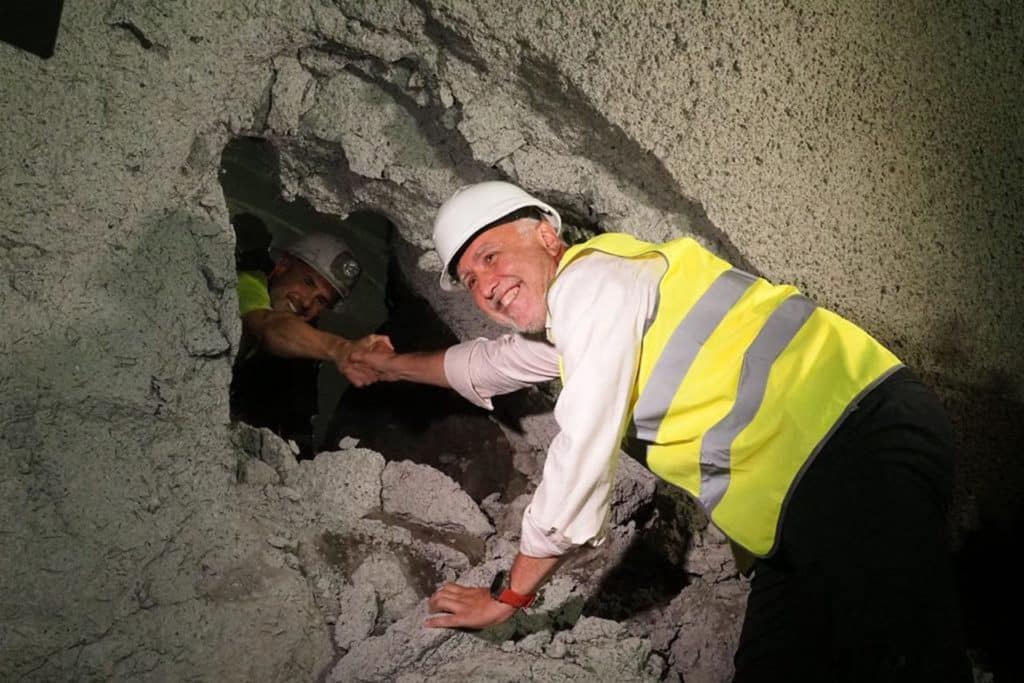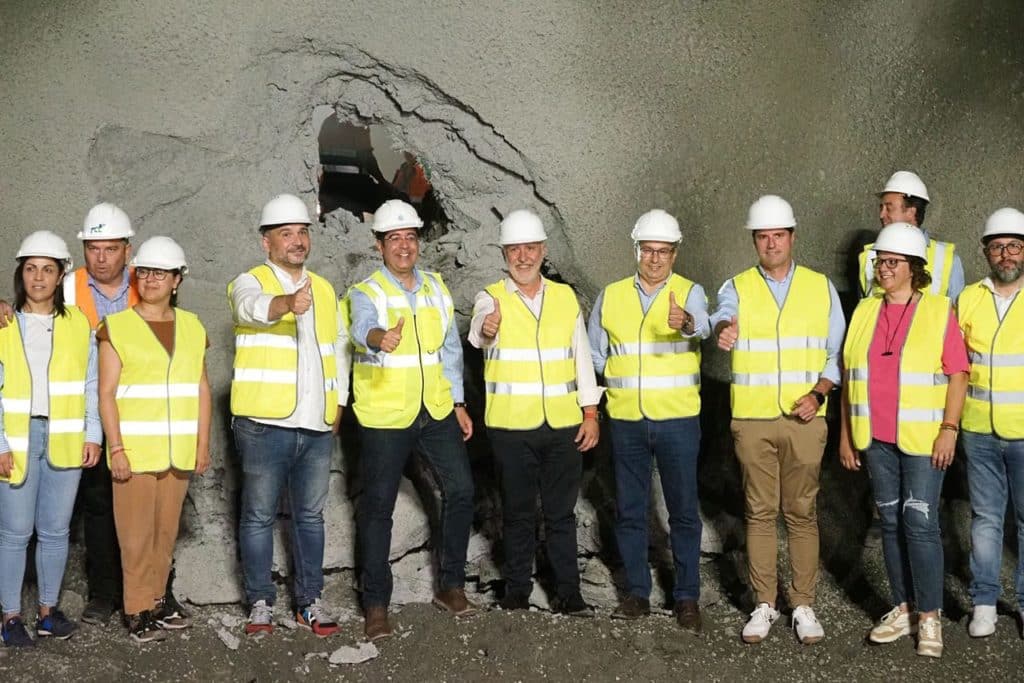The air already circulates between the North and the South under the Teno massif. Three and a half years after the bulldozers started working on the Erjos tunnelYesterday, heavy machinery mechanically drilled the last two meters of the wall that separated one of the two galleries drilled from Santiago del Teide and El Tanque, thus completing the union of both sections after digging 4,855 meters.
The second tunnel, which runs parallel, has already drilled 4,555 meters, which is equivalent to 97% of the underground passage, so there are only 300 meters left to execute. The section will be completed in August, according to the forecast of the Ministry of Public Works, Transport and Housing.
The works will be completed with two false tunnels (140 meters in the south mouth and 100 meters in the north mouth), which will increase the length of the longest tunnel in the Canary Islands -and one of the longest in Spain- to 5.1 kilometers foreseen in the project.
With the draft yesterday of the first of the two tunnels that will close the western section -the most complicated- of the Insular Ring, the forecasts advanced to DIARIO DE AVISOS last October by the general director of Road Infrastructure, José Luis Delgado, have been met, which then, with 60% of the drilling done, he anticipated that the two north-south mouths would meet in summer.
To speed up the excavation, drilling has been carried out simultaneously in the four mouths, without interruption, 24 hours a day through three eight-hour work shifts, seven days a week. Robotic excavating machines have been used and the perforations have been carried out mainly by blasting and through mechanical means, depending on the conditions of the terrain, which has allowed an average of 15 meters to be advanced per day.

The vehicles will begin to circulate in a period of no less than 15 months through the double underpass, which will be key to alleviating the traffic load supported by the TF-5 motorway and will facilitate economic dynamism between the north and south of the Island. , circulation will be safer and faster.
It is expected that 17,000 cars will use the dual carriageway daily to cross the Teno massif, an amount that far exceeds the initial forecast of 5,000 cars. Technical studies indicate that within a decade traffic will be more than 30,000 vehicles. “It is the beginning of the end of the queues”, summed up José Luis Delgado, convinced that the largest road engineering work carried out in the Canary Islands will mark “a before and after” in island mobility, an argument that he reinforced with a Example: “Someone who lives in Tacoronte and has to move to the South will save time on the West of the Island.”

Drivers heading from El Tanque to Santiago del Teide (and vice versa) will gain more than 20 minutes compared to the current road layout of the TF-82, a mountain road with numerous curves. The new stretch of highway, which when completed will join the rest of the TF-5, is 11.3 kilometers long, almost half of which will be underground.
Numerous authorities and technical managers of the work attended the act of drilling, the term used to complete the drilling. The acting President of the Government of the Canary Islands, Ángel Víctor Torres, indicated that it is “a job well done in these four years, in which, of the 16 projects of the road agreement for Tenerife, a total of 13 are already in the phase of bidding, in works and with environmental impact statements”.
In addition, he recalled that “the improvement of the infrastructures has been a priority of my Government and I hope that it will be the new one, so that, in 15 months, this work can be delivered to the people of Tenerife”.
A task on which we have focused a lot of efforts during this mandate from the Cabildo and the Government of the Canary Islands has been to advance in highway projects. Today the tunnel coming from the north and the one from the south have been joined with the meeting of the two excavations. pic.twitter.com/vXDJZeOz4Z
— Pedro Martin (@PedroMartinTfe) June 26, 2023
The acting president of the Cabildo, Pedro Martín, stressed that “during this mandate, the island institution has focused all its efforts, together with the Government of the Canary Islands, on advancing road projects and the execution of works” and described the underground infrastructure of “a great milestone” for Tenerife.
For his part, the mayor of Santiago del Teide, Emilio Navarro, referred to the work as “the most important to be carried out in Spain, not only for the economic part, but also on a social, health and family reconciliation level.” Also in attendance were Esther Morales, mayoress of El Tanque; Carmen Luz Baso, councilor of Los Silos, and Eva García, mayoress of Buenavista.
The Erjos double tunnel, one of the most expensive and complicated public works due to the orographic conditions of the area, was awarded in 2019 for 241 million euros, although the price updates applied to the works have caused a stretch in the budget up to 256 million. Of that amount, 18 are allocated to environmental actions in the surroundings of the work. Given that the Government of the Canary Islands has paid certifications worth 120,334,038 euros of the total budget for the work, charged to the Canary Islands-State highway agreement (2018-2027), the level of execution of the initial budget is already close to 47%. .
The machines began to operate in the municipality of Santiago del Teide on November 25, 2019 by the Temporary Business Union formed by Fomento Construcciones y Contratas (FCC), El Silbo and Syocsa-Inarsa. The work directly employs 102 workers, including operators and specialized personnel, and 204 more people adding suppliers, drivers and catering personnel who serve the workers.















